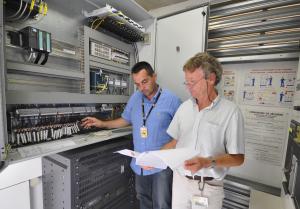Mini CODAC, maxi efficiency
9 Sep 2011
-
Robert Arnoux
Without CODAC, the ITER machine would be like a Tower of Babel: systems and components would each speak their own language and total confusion would result.
Joël Hourtoule (left) and Jean-Yves Journeaux in one of the twin "control towers" that collect and dispatch electrical power as well as data, thus providing a real-time picture of what's going on, electrically speaking, on the ITER worksite.
CODAC, which stands for Control, Data Access and Communication, is the central control system—the "common language" responsible for operating ITER. Section Leader Anders Wallander defines CODAC as "a system which, from an operational point of view, makes one entity of everything."
Over the course of the years, CODAC standards for ITER were established and a documentation package, called the Plant Control Design Handbook (PCDH), was published to provide guidelines and specifications to the industry for Instrumentation and Control (I&C). A reference to the PCDH is now attached to every Procurement Arrangement signed between the ITER Organization and a Domestic Agency.
The ITER machine and plant systems will not be fully operational before the end of the decade but a light version of CODAC—dubbed "mini CODAC"—is already being implemented on the ITER construction site.
"We needed an illustration of what the CODAC system really is," explains Jean-Yves Journeaux, a member of the CODAC team and the responsible officer for PCDH. "We needed to verify that our solutions were efficient and appropriate, and that our clients endorsed them."
The distribution of electrical power to the ITER worksite provided just the "user case" that the CODAC team needed. Until recently, distributing 15kV electrical power to the construction companies on the site (what Journeaux calls the "clients") relied on a rather primitive system. Meters, for instance, were not centralized and had to be read manually.
"We lacked an efficient control and command system," says Joël Hourtoule, section leader for ITER's steady state electrical network (SSEN). "We realized we could provide the CODAC team with a pertinent user case."
What the CODAC Team has implemented for the electrical distribution, command and control on the ITER worksite "is no laboratory tool," stresses Hourtoule. "It is the first truly operational ITER system."
The system core is hosted in two small concrete buildings located at the back of the current office buildings on the ITER site, labelled Load Centre B91 and B92. The two buildings are like twin control towers, collecting and dispatching electrical power as well as data and providing Hourtoule and the operations team with a real-time picture of what's going on, electrically speaking, on the ITER worksite.
The present electrical consumption on the ITER worksite is equivalent to that of some one hundred households (~ 1MW), and significantly more when the concrete batching plants are operating. Consumption will be multiplied by ten when assembly of the ITER poloidal field coils is underway in the Winding Facility and the cryostat is being assembled.
"We're working with Fusion for Energy to extend the use case to the monitoring of the Poloidal Field Coils Winding Facility," says Journeaux. "It will be the first time we work directly with a Domestic Agency on something tangible. For us at CODAC, the 'hands-on' is about to begin."


